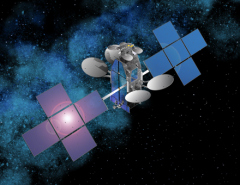One of the more intriguing things I came across at the Consumer Electronics Show back in Las Vegas was a new satellite broadband service from U.S. provider ViaSat. Coming off the launch of its ViaSat 1 satellite back in October, the company announced some relatively fast and inexpensive home internet services at the show.
Satellite broadband has always been something of a Rodney Dangerfield of the internet world - because it has generally been slow and expensive, it never got any respect. ViaSat’s new Exede service, which boasts download speeds of about 12 megabits a second for $50 a month, looks like it could start inching broadband internet toward respectability. (Incidentally, Canada’s Xplornet is also using ViaSat 1 - while the company doesn’t yet offer that 12-megabit option, a spokesperson said it is under consideration.)
I had a brief exchange with Vint Cerf over ViaSat’s service and he was bullish on satellite broadband in general. Cerf, of course, is often considered one of the fathers of the internet for writing the technical protocols on which it is based back in the 1970s, while today he is a vice-president and “chief internet evangelist” for Google. He’s also working with NASA to improve satellite communications. Some of his comments ended up in a short post I did for New Scientist.
I chatted with Cerf the other day for something else I’m working on, so I took the opportunity to ask him to expand on his satellite broadband optimism. I asked if the technology is also subject to Moore’s Law, the phenomenon that sees computer processing power and related aspects double roughly every 18 months, and here’s what he said:
“Sort of. We need to be a little bit careful because Moore’s Law primarily has to do with the area of an active element in a digital circuit. Satellite communications, while it can have increasing amounts of processing power – which implies for example putting packet switching up in the satellite, which only one company has done and that’s Cisco at least that I’m aware of – we can do interesting things like that. On the other hand, it doesn’t necessarily generate more bandwidth.
“So if the purpose of the satellite is communication, getting more capacity is often a question of getting more frequency that you’re operating at. Here you have all kinds of questions about higher frequencies with more bandwidth, but the propagation is more difficult because it has to go through the atmosphere and, depending on where the satellite is, you may lose signal-to-noise ratio and eventually you don’t have a well-functioning equation.
“It is true that we could be moving into higher frequencies. We’re already up in the 30 and 40 gigahertz range if I remember correctly, and certainly in 20 and 30, which can provide an increase in capacity, but it’s not exactly the same. I’d be a little careful to overly analogize there.
“There is one other thing that’s rather interesting. There’s a company called O3B, which stands for ‘other three billion,’ and Google is an investor so I’m of course somewhat biased, but the reason they’re interesting is it is not a synchronous satellite (that they’re using), it is in fact at 8,000-kilometres orbit. There are a dozen of these satellites and the reason being is since they’re not synchronous, you need to have a bunch of them so that there’s always one or two in view.
“This particular design allows for gigabit spot beams, and that’s actually a fair amount of capacity. Because it’s in lower orbit, you get higher signal to noise ratio because you have more power and less distance to go. Also, the round-trip-time delay going through the satellite is much less – it’s more like 50 milliseconds instead of 250 for a synchronous satellite.
“There are a lot of nice things about that. The particular satellite set or constellation that’s proposed will have beams reaching 40 degrees north and south of the equator, which if you look at the globe or Google Earth, it covers a substantial part of the Pacific Rim, especially the islands, sub-Saharan Africa, in addition to north of the equator.
“I think we’re going to see some pretty creative ways of using satellite capacity, including packet switching in the satellite itself, over the next decade.”
So, to parse that a little bit, satellite broadband is improving in several ways. One of its big problems isn’t necessarily speeds or capacity, but its delay. Because a home user’s internet signal essentially has to go up into space and back again, it experiences a much longer round trip than over terrestrial cables. That makes it tougher for real-time internet applications such as VoIP or online gaming to work properly. But with lower-orbit satellites providing less delay, the situation can be somewhat ameliorated.
In a nutshell, while satellite broadband may never match the high quality of earth-bound cables, Cerf thinks it’s going to continue improving, which is certainly good news for people living in areas where there are no other options.


bwalzer
February 27, 2012 at 9:14 am
The first question to ask when hearing about satellite internet access is: What is the upstream bandwidth? Downstream is easy. Upstream is hard.
petenowak2000
February 27, 2012 at 10:28 am
The upload speed on ViaSat’s 12 Mbps service is 3 Mbps, which is considerably faster than what many terrestrial ISPs offer for the same price.